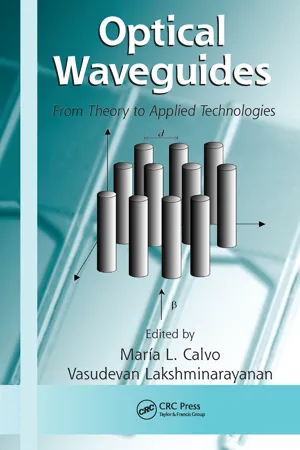
Optical Waveguides
From Theory to Applied Technologies
- 424 pages
- English
- ePUB (mobile friendly)
- Available on iOS & Android
About This Book
Although the theory and principles of optical waveguides have been established for more than a century, the technologies have only been realized in recent decades. Optical Waveguides: From Theory to Applied Technologies combines the most relevant aspects of waveguide theory with the study of current detailed waveguiding technologies, in particular, photonic devices, telecommunication applications, and biomedical optics.
With self-contained chapters written by well-known specialists, the book features both fundamentals and applications. The first three chapters examine the theoretical foundations and bases of planar optical waveguides as well as critical optical properties such as birefringence and nonlinear optical phenomena. The next several chapters focus on contemporary waveguiding technologies that include photonic devices and telecommunications. The book concludes with discussions on additional technological applications, including biomedical optical waveguides and the potential of neutron waveguides.
As optical waveguides play an increasing part in modern technology, photonics will become to the 21st century what electronics were to the 20th century. Offering both novel insights for experienced professionals and introductory material for novices, this book facilitates a better understanding of the new information era—the photonics century.
Frequently asked questions
Information
(1.1) |

Table of contents
- Cover
- Half Title
- Title Page
- Copyright Page
- Table of Contents
- Chapter 1 Propagation Characteristics of Planar Waveguides
- Chapter 2 Birefringent Optical Waveguides
- Chapter 3 Optically Induced Nonlinear Waveguides
- Chapter 4 Active Optical Waveguides
- Chapter 5 Wavelength Dispersive Planar Waveguide Devices: Echelle and Arrayed Waveguide Gratings
- Chapter 6 Silicon Waveguides for Integrated Optics
- Chapter 7 Enabling Fabrication Technologies for Planar Waveguide Devices
- Chapter 8 Biomedical Fiber Optics
- Chapter 9 Neutron Waveguides and Applications
- Index